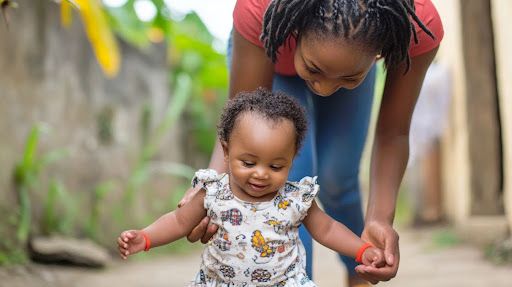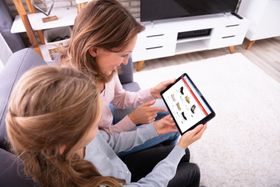7 Signs Your Baby Will Walk Soon: Prep for Steps
Published December 10, 2024

Watching your baby prepare to walk is like witnessing a miniature miracle of human development. Those wobbly attempts at mobility are more than just cute moments—they're complex physical and cognitive achievements.
Understanding the signs that your little one is approaching their walking milestone can help you support their journey and celebrate each incredible step.
» Support their first steps with the best pre-walker footwear
When Do Babies Start Walking?
Every baby's journey to walking is unique, but most take their first independent steps between 9 and 18 months. This exciting milestone isn't just about physical development; it's also a cognitive leap as babies learn to coordinate their movements and perceive their surroundings.
Walking isn't a sudden skill but a gradual process involving multiple physical developments. Babies progressively build strength, balance, and coordination through several key stages.
» Discover how to pick shoes for different stages of your kid's development
7 Signs Your Baby Will Walk Soon
- The Cruising Champion
- Master of Position Changes
- The Imitation Game
- Risk-Taking Behavior
- Increased Curiosity and Exploration
- Muscle Strength and Coordination
- Enhanced Weight-Bearing Skills
» Give your little one the best start with supportive and stylish high-top shoes
1. The Cruising Champion
Cruising is essentially your baby's first "walking rehearsal." When your little one starts moving sideways while holding furniture, they develop critical walking skills. This isn't just random movement—it's a strategic process of building muscle strength, balance, and spatial awareness.
Key indicators include:
- Confidently moving along couches and chairs
- Transferring weight smoothly from one leg to another
- Using furniture as a support system while exploring the room
» Give your prewalker the best with these supportive shoes
2. Master of Position Changes
Babies preparing to walk become movement experts. They constantly shift between sitting, crawling, kneeling, and standing positions. These transitions might seem chaotic, but they're sophisticated motor skill training.
Watch for:
- Smooth transitions between different body positions
- Increased comfort moving between sitting and standing
- Deliberate attempts to challenge their balance
» Try these picks for comfort and support while learning to walk
3. The Imitation Game
Babies are natural mimics, and this becomes significantly pronounced when they're close to walking. They'll watch adults and older children intently, trying to copy walking patterns and movements.
Signs include:
- Holding onto caregivers' hands to "practice" walking
- Paying close attention to people walking
- Attempting to stand and move like the big people around them
» Ensure a blend of support and flexibility as your baby learns to walk
4. Risk-Taking Behavior
As confidence builds, babies start taking tiny, calculated risks. These aren't reckless moments—they're carefully considered attempts to test physical boundaries.
Look out for:
- Briefly letting go of furniture while cruising
- Attempting to stand without hand support
- Taking experimental, wobbly solo steps
» Protect their delicate feet and learn to prevent kids' foot injuries
5. Increased Curiosity and Exploration
A baby on the brink of walking becomes incredibly curious about their environment. They're no longer content to sit and observe—they want to investigate everything.
Indicators include:
- Attempting to reach objects in previously inaccessible areas
- Showing heightened interest in moving through different spaces
- Demonstrating a clear desire for independence
» Understand the best ways to treat kid growing pains
6. Muscle Strength and Coordination
Physical development is key to walking. Babies will show increased strength through various activities that seem unrelated but are crucial preparation.
Watch for:
- Confidently pulling themselves up
- Bouncing while standing
- Using toes to grip surfaces for stability
» Find out what to look for in orthopaedic shoes
7. Enhanced Weight-Bearing Skills
The ability to support body weight is a fundamental walking prerequisite. Babies will increasingly practice standing and bearing their weight.
Signs include:
- Standing with support for more extended periods
- Bouncing while standing
- Showing comfort and stability when upright
» Check out the best sandals for kids learning to walk
Creating a Supportive Environment
Encouraging walking isn't just about waiting—parents can actively support their baby's development:
- Childproof the Space: Remove potential hazards by covering sharp edges, anchoring heavy furniture, and keeping small objects out of reach.
- Encourage Barefoot Time: Walking barefoot helps develop natural foot arch, improves balance, and enhances proprioception
- Design Safe Exploration Areas: Use soft mats, create open spaces, and arrange furniture strategically to provide safe cruising opportunities.
» Support their first steps with shoes designed for babies learning to walk
Supporting their Walking Journey
Every baby's walking journey is unique. Some will zoom across rooms early, while others take a more gradual approach. The key is providing a safe environment that encourages exploration and builds confidence.
To support this milestone, consider investing in specialised footwear like First Walkers' pre-walker shoes. Designed with careful attention to infant foot development, these shoes provide the perfect balance of support and flexibility, helping your little one transition from cruising to confident walking with comfort and stability.
Disclaimer: First Walkers' information is intended for educational and informational purposes related to toddler footwear and feet. We encourage you to consider individual circumstances and consult qualified orthopaedists about specific conditions.





